1977: The 800-mile-long Trans-Alaska Pipeline System is completed.
The Alaskan pipeline, built to help slake America's insatiable thirst for oil, was designed to move oil from the fertile fields of the North Slope to Valdez, Alaska's northernmost ice-free port.
The pipeline was an engineering marvel, considering the terrain that had to be negotiated: Three mountain ranges and numerous rivers and streams stood between all those thirsty SUVs and their sustenance. The project, which was privately funded, cost $8 billion.
Since turning on the spigot on June 20, 1977, more than 14 billion barrels of oil have flowed to the storage tanks at Valdez. The ARCO Juneau was the first tanker to carry crude through Prince William Sound. Around 20,000 ships have made the trip since, most notoriously the Exxon Valdez, which ran aground in 1989, spilling roughly 11 million gallons of oil and causing one of the worst ecological disasters in U.S. history.
The effects of that catastrophe are still being felt to this day, which didn't stop the George W. Bush administration from pushing to open more oil fields at the North Slope for exploration and exploitation.
(Source: NOAA, Alyeska Pipeline.com)
This article first appeared on Wired.com May 31, 2007.
See Also:- March 24, 1989: Valdez Spill Causes Environmental Catastrophe
